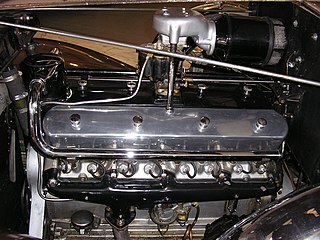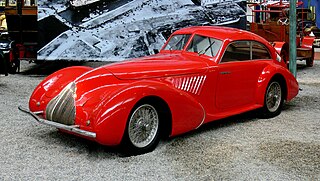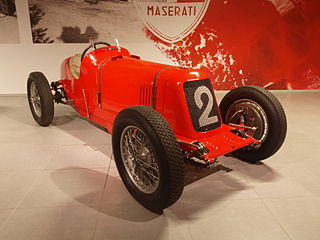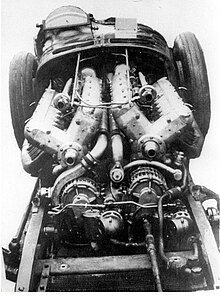
A V16 engine is a sixteen-cylinder piston engine where two banks of eight cylinders are arranged in a V configuration around a common crankshaft. V16 engines are less common than engines with fewer cylinders, such as V8 and V12 engines. Each bank of a V16 engine can be thought of as a straight-8, a design that can be inherently balanced. Most V16 engines have a 45° bank angle.

The Alfa Romeo 8C was originally a range of Alfa Romeo road, race and sports cars of the 1930s. In 2004 Alfa Romeo revived the 8C name for a V8-engined concept car which made it into production for 2007, the 8C Competizione.

Maserati Ghibli is the name of three different cars produced by Italian automobile manufacturer Maserati: the AM115, a V8 grand tourer from 1967 to 1973; the AM336, a V6 twin-turbocharged coupé from 1992 to 1998; and the M157, an executive saloon from 2013 onwards.
The British Racing Motors V16 was a supercharged 1.5-litre V-16 cylinder racing engine built by British Racing Motors (BRM) for competing in Formula One motor racing in the immediate aftermath of World War II. Designed in 1947 and raced until 1954–55, it produced 600 bhp (450 kW) at 12,000 rpm, although test figures from Rolls-Royce suggested that the engine would be able to be run at up to 14,000rpm.

The Maserati 250F was a racing car made by Maserati of Italy used in '2.5 litre' Formula One racing between January 1954 and November 1960. Twenty-six examples were made.

Maserati A6 were a series of grand tourers, racing sports cars and single seaters made by Maserati of Italy between 1947 and 1956. They were named for Alfieri Maserati and for their straight-six engine.

Maserati 150S is a racing car made by Maserati of Italy alongside the Maserati 200S, to take over for the aging Maserati A6GCS racing variants. Depending on the source, between twenty-four and twenty-seven examples were built, and one additional street-going car, called the Maserati 150 GT.

The Maserati Tipo 151 is a racing car manufactured by Italian automobile manufacturer Maserati for the 1962 LeMans season to compete in the experimental GT car class. Three cars were built in total, one for Johnny Simone of Maserati France with a red exterior colour and white tri-stripes whilst two were built for Briggs Cunningham for his racing team. These cars had a white body with two blue stripes.

The Maserati Tipo 60/61 are a series of sports racing cars produced between 1959 and 1961 by Italian automobile manufacturer Maserati for privateers racing in sports car events including the 24 Hours of Le Mans in the 2-litre and 3-litre racing category. It used an intricate tubular space frame chassis, containing about 200 chro-moly steel tubes welded together, arranged triangular formation at high stress areas of the chassis, hence the nickname "Birdcage". This method of construction provided a more rigid and, at the same time, lighter chassis than other racing cars of the time.

The Maserati 8C was a Grand Prix race car built by Maserati between 1931 and 1933. The 8C was being designed by Alfieri Maserati in the early 1930s; however, he died before its completion. The chassis was that of the Maserati Tipo 26M, and it was initially fitted with a Tipo 26M engine with its cylinders bored out by 4 mm to arrive at its limit of 2.8 litres (2,812 cc) for 69 x 94 mm bore and stroke. Development of the new 3.0 L engine continued and it was constructed for racing in 1932. The car won the 1933 French Grand Prix and Sir Henry Birkin achieved third place driving it in the Tripoli Grand Prix. However, it was not very successful in other races. The car featured some of the world's earliest hydraulic brakes. The Tipo 8C 3000 was the final two-seater Grand Prix Maserati, and was succeeded in 1933 by the Maserati 8CM, M for monoposto.

The 1935 Grand Prix season was the second year of the new 750 kg Formula. The success of the previous year encouraged the AIACR to reinitiate the European Championship. It was composed of the seven national Grands Prix and was won by Rudolf Caracciola, driving for the Mercedes-Benz team. The team dominated the season winning five of those Grand Épreuves, as well as four of the other major races of the season. However, in one of the great motor-races in sporting history, Tazio Nuvolari in a Scuderia Ferrari Alfa Romeo beat the combined numbers of the German teams in their home Grand Prix. The season also saw the arrival on the international stage of the bright young talent Bernd Rosemeyer in the Auto Union team.

The 1931 Grand Prix season was a watershed year, with the advent of the AIACR European Championship. After several years of Grand Prix racing in the doldrums with little technical development, 1931 saw new models come from all three main manufacturers: Bugatti, Maserati and Alfa Romeo.
The 1934 Grand Prix season saw the advent of the new 750 kg Formula. In an effort to curb the danger of rising speeds, the AIACR imposed this upper weight limit that effectively outlawed the large capacity engines. The incumbent manufacturers Alfa Romeo, Maserati and Bugatti had been preparing their new models with varying success – the best of which was the Alfa Romeo Tipo B. However, it was the state-sponsored arrival of the two German teams, Mercedes-Benz and Auto Union, and their innovative and progressive cars that ignited a new, exciting era of motor racing.

The Cooper T51 was a Formula One and Formula Two racing car designed by Owen Maddock and built by the Cooper Car Company for the 1959 Formula One season. The T51 earned a significant place in motor racing history when Jack Brabham drove the car to become the first driver to win the World Championship of Drivers with an engine mounted behind them, in 1959. The T51 was raced in several configurations by various entrants until 1963 and in all no less than 38 drivers were entered to drive T51s in Grand Prix races.

The Auto Union Grand Prix racing cars types A to D were developed and built by a specialist racing department of Auto Union's Horch works in Zwickau, Germany, between 1933 and 1939, after the company bought a design by Dr. Ferdinand Porsche in 1933. The Auto Union type B streamlined body was designed by Paul Jaray.

The BRM P25 was a Formula One racing car raced from 1956 to 1960 and the second car produced by the British Racing Motors consortium. After the failure of the complex BRM V16, the P25's design emphasized simplicity. The car was fitted with a 2.5-litre straight-4 engine, producing some 275 horsepower. The P25 would be the foundation of BRM's successes in the late 1950s and early 1960s.

The Maserati Tipo 26B or Maserati Tipo 26B Monoposto was a racing car built by Italian manufacturer Maserati between 1927 and 1930, in a total of six examples and one additional engine.

The Ferrari 166 F2 is an open-wheel formula racing single-seater car, designed, developed and built by Italian manufacturer and team Scuderia Ferrari, for Formula 2 racing, in 1948. This is the car in which Argentinian driver, and eventual five-time Formula One world champion, Juan Manuel Fangio, became known in Europe.

The Maserati 4CM is an open-wheel Grand Prix motor racing car, designed, developed and built by Italian manufacturer Maserati, in 1931.

The Maserati 8CTF is an open-wheel Grand Prix motor racing car, designed, developed and built by Italian manufacturer Maserati, from 1938 to 1939. To date, it remains the only Italian-made car to win the Indianapolis 500.



















